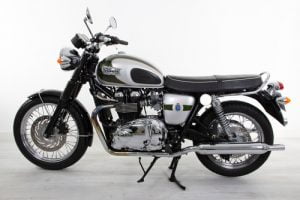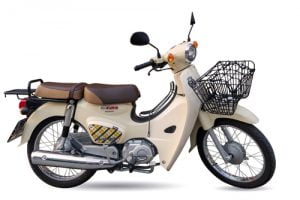
A motorcycle is more usually referred to as a “motorbike” and sometimes as just a “bike”. It can most simply be described as a two-wheeled motorised vehicle. Like the greater majority of inventions, the motorcycle we know it today has evolved over time. Thus, there is no single individual that could lay claim to being its sole inventor. In fact, it should come as any great surprise to learn that the invention of the motorcycle is firmly rooted in the development of the bicycle.
The Steam Pioneers
The earliest versions of the motorcycle were developed in parallel on both sides of the Atlantic. In 1867, Frenchman Ernest Michaux attached a small steam engine to the ‘velocipede’ he had helped develop with his father, Pierre Michaux. His ‘motorcycle’ had a twin-belt drive, propelled by steam, that drove the front wheel. A year later, American Sylvester Howard Roper came up with a prototype two-cylinder, steam-powered bicycle. In 1871, French engineer Louis-Guillaume Perreaux developed a steam one-cylinder bicycle with an alcohol burner.

Replica of Sylvester Roper’s 1868 steam-powered bicycle Photo credit: lennystan/Shutterstock.com
In 1881, the pioneering 19th-century engineer and inventor Lucius Day Copeland also created a steam-powered bicycle. Named the ‘Copeland’, it was an ‘American Star’ high-wheeler bicycle with a steam boiler. It was first demonstrated at the Arizona Territorial Fair in 1884. The ‘Copeland’, was a penny-farthing in reverse, i.e. it had a small front-wheel and large rear-wheel. It reportedly reached the breakneck speed of 12 mph during trials. In 1887, Copeland set up the Northrop Manufacturing Co. in Camden, New Jersey. It began the production of a three-wheeled version of the ‘Star’, the “Phaeton Moto-Cycle”. He demonstrated his new invention at the Smithsonian Institution in Washington D.C. in 1888.
Birth of the Motorcycle
While America pressed ahead with steam-power, a revolution in the development of the motorcycle had already happened on the other side of the Atlantic. In 1885, the German inventors Gottlieb Daimler and Wilhelm Maybach managed to strap a 264 cc diesel internal combustion engine to a wooden bicycle. They named their machine the “Daimler Reitwagen” (riding wagon), which today is widely regarded as the earliest example of a motorcycle. The German innovation was the start of the revolution in road transport. It essentially paved the way for the future development of all internal combustion engine vehicles.

Replica of the 1885 Daimler Reitwagen (Riding wagon) Photo credit: Armensl/Shutterstock.com
In 1894, German manufacturer “Hildebrand & Wolfmüller” became the world’s first company to mass-produce a motorcycle. However, the firm only ever produced a few hundred machines before it found itself in financial difficulties and closed. In 1895, the American inventor E.J. Pennington demonstrated the prototype of his motorcycle which reached a top speed of 58mph. Within a few years, many new motorcycle makers had begun building their machines in numerous countries around the world.
Early Manufacture
In 1897, the Parisian-based brothers Eugene and Michel Werner began their venture into the production of motorcycles. Within a year, they had built and patented the cradle-frame engine, which is still used today by most motorcycle manufacturers. In 1899, Werner produced the first purpose-built motorcycle, which had a strengthened frame and a 216 cc engine of company design. Soon after, several famed engineering companies started their own production of motorcycles. These included the notable British companies of Royal Enfield, Norton, and Triumph, and the equally famed American producers, Harley-Davidson and Indian.
It was during this period, the popular new sport of motorcycle racing arrived. This drove innovation for the development and production of ever more powerful, faster, and more reliable machines. Advancements in design soon found their way into the mass-produced motorcycles. In 1907, the first major motorcycle racing event on the open road took place on the Isle of Man. The world-famous Manx T.T. (Tourist Trophy) has been run almost every year since the inaugural event of 1907.
Motorcycling for the Masses
During WWI, motorbike production was greatly ramped up for the war effort. To enhance communications, messengers on horseback began to be replaced with dispatch riders on motorcycles. Triumph was able to sell more than 30,000 of its Type H model to allied forces during the war. By 1920, Harley-Davidson was the world’s leading manufacturer of motorcycles. The company was producing more than 28,000 machines annually and selling to 67 countries across the world. By 1930, German company DKW had taken over the mantle as the globe’s biggest motorcycle manufacturer, which saw their smaller machines proving popular.
By the 1930s, there were more than 80 different motorcycle manufacturers in Britain alone. Motorcycles like BSA, AJS, Vincent, and Velocette, became familiar names alongside the already established makers. After WW2, the ownership of motorcycles began to soar in the western world, especially America. Many servicemen returning to civilian life after the conflict had experienced the thrill of motorcycling and wanted to own a ‘bike’ for themselves.

The iconic ‘Triumph T100 Bonneville’ – first produced in 1963 Photo credit: sylv1rob1/Shutterstock.com
A Japanese Takeover
During the 1960s, the dominance of American and British motorcycle manufacturers began to wane with the emergence of Japanese companies. Namely, Honda, Suzuki, Kawasaki, and Yamaha, whose main focus was on the production of smaller, more efficient, and most importantly, cheaper motorcycles. This strategy helped them to secure a huge slice of the world market, which saw Honda being easily the most successful.
In the 1990s, well-established western motorcycle manufacturers such as BMW, Ducati, and Harley-Davidson managed to retake some of the market share lost to Japan. Their brands were, in particular, popular with motorcycling enthusiasts whose pockets were a little deeper than the average punter.
Motorcycling in the 21st Century
Today, motorcycling is perhaps not as popular as it once in Western culture, due to various factors such as road safety concerns and comparative transport costs. However, during the 21st-century, motorcycles have become a popular cost-effective method of transport in many developing countries. Some of today’s largest motorcycle manufacturing companies are now based in India and China. Mass-produced, cheap, small cc motorbikes have replaced the bicycle as an everyday means of transport for millions. In Southeast Asian countries such as Thailand, Vietnam, and Indonesia, there is more than 80 percent household ownership of a motorcycle. Today (2021) total motorcycle ownership across the world is estimated to be between 300 – 400 million.
Did you know?
The world’s best-selling motorbike of all time is the Honda Super Cub. It first rolled off the production line at Honda’s Yamato Plant, just north of Tokyo, in August 1958. Since then it has been sold in more than 160 countries around the world. In 2017, Honda announced that the cumulative 100 millionth sale of the Super Cub had been reached.

The ‘Honda Super Cub’ – the world’s top-selling motorcycle Photo credit: Thisislove/Shutterstock.com
Header Image Credit: Alexander Kirch/Shutterstock.com
If you’ve enjoyed reading this article, why not click on the link to Hobbies and Pastimes, to see if there’s anything else that takes your interest?





